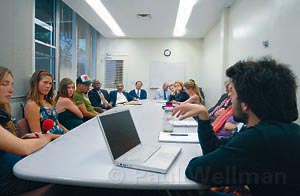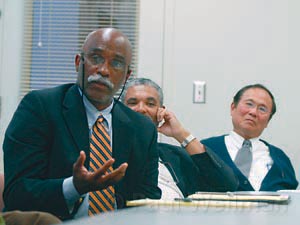What an Education
Student Fast to Protest UC Nukes Involvement

A dozen UCSB students began a hunger strike on Wednesday morning, May 9, with some pledging to fast until the University of California agrees to stop “engineering, testing, and manufacturing nuclear weapons.” Last year, the UC system received $15 million from the U.S. Department of Energy to manage the Los Alamos National Laboratory in New Mexico and the Lawrence Livermore National Laboratory in Northern California. That is equal to one-quarter of the UC system’s entire operating budget, according to the protesters. UC has managed the labs ever since the atomic bomb was developed at Los Alamos in 1943, during World War II. On Tuesday morning, May 8, UC and its private partners-including Bechtel Corporation-again won the bid to continue managing Lawrence Livermore, competing for the contract against Northrop Grumman.
The hunger strike is timed to highlight the U.S. Nuclear Weapons Council’s announcement in March that Lawrence Livermore will design a new hydrogen bomb, officially the nation’s first new nuclear weapon since the end of the Cold War, according to one of the hunger strike organizers, Will Parrish, a UC Santa Cruz graduate who works at the Nuclear Age Peace Foundation (NAPF) in Santa Barbara. Hydrogen bombs fuse atoms and are up to 40 times more powerful than nuclear fission bombs, which split atoms.

Handfuls of UC Santa Cruz and UC Berkeley students are also participating in the fast. The fasting students are camping on the lawn outside the campus administration building, Cheadle Hall. The last UCSB hunger strike took place in the early 1990s, part of a battle over ethnic studies requirements.
In addition to protesting the new hydrogen bomb, the hunger strikers want to call attention to the Los Alamos lab’s plans to resume manufacture of plutonium bomb cores in 2008 as part of the Bush administration’s Reliable Replacement Warhead program. The last “pits,” as the plutonium cores are called, were produced at the Rocky Flats weapons production facility in 1999. Nuclear disarmament advocates have been fighting new pit production at Los Alamos since 1998 via lawsuits, targeting inadequate environmental reports. The third reason hunger strikers have given for fasting is the presence of U.S. nuclear attack subs in the waters off Iran. The submarines are armed with “small yield” weapons-the B61-11-which, if used, would kill tens of thousands of civilians and irradiate Iran’s environment, according to a statement by the Nuclear Age Peace Foundation. The weapons were developed at Los Alamos in the 1990s. Andrew Culp, another strike organizer, said that one of the major drawbacks to such nuclear weaponry is that “the smallest mishap can lead to nuclear war.” Culp, who works for the NAPF as a researcher and outreach organizer, claimed that all of these weapon-building activities violate the Nuclear Non-Proliferation Treaty of 1970.
The amount of money that the UC system receives from the Department of Energy for managing the labs far exceeds the amount it gets from the Department of Defense, which totaled about $300 million over the past 10 years, according to documents that Culp requested and received through the Freedom of Information Act. Apart from the nuclear weapons labs, the UC system engages in no classified defense work whatsoever, according to Culp’s research. “The majority of UC’s scientific research money is still National Science Foundation,” said Culp. “They have top-notch people deciding what kind of research to do,” he added. Even so, he said, UC scientists do some hair-raising unclassified work: For example, scientists are working on swarming techniques for unmanned aerial vehicles (UAVs). “They are basically making The Terminator. So you could eventually have one hundred UAVs swarming and independently bombing and machine-gunning targets of their own choice,” Culp said of the possible combination of swarming technology with another project called “independent target acquisition.” Culp noted that UC faculty take few such contracts, however. By contrast, Lawrence Livermore and Los Alamos employ hundreds of UC graduates and researchers. Some non-military work is also performed at the labs, including climatology that takes advantage of the facilities’ high-speed computers.
The core group of fasters has been preparing themselves well, Culp said, first eliminating their consumption of solid foods, then soups and juices, until some were ready to begin water fasts on Wednesday. Other students may join in for just one meal or one day. Organizers have planned activities for the duration of the strike, including carnival games, teach-ins, poetry, music, chalk drawings, and movies. No one is likely to die, according to Michael Young, UCSB’s Vice-Chancellor for Student Affairs, who wrote in answer to inquiries that “We do not intend to allow any student to endanger his or her life with this action.”
In what has been called a parallel campaign, on April 25, the Associated Students of UCSB established a new legislative committee to oversee the two UC nuclear weapons labs. One of its members, UCSB sociology major Darwin BondGraham, is writing an informational report about the labs that the group hopes to share not only with students but with the UC regents, state office holders, and congressional representatives as well.
The fast is part of a continuum of efforts by nuclear abolitionist groups, which have gained in intensity with the Bush administration’s focus on atomic weaponry, interest in which had flagged following the end of the Cold War. In the 100 days before UC President Robert C. Dynes took office in January 2004, anti-nuclear weapons advocates sent Dynes one letter each day urging the former Los Alamos physicist to sever ties to the labs. Much more recently, when the Board of Regents, which governs the UC system, met in Santa Cruz, activists demanding a conversation with the regents were forcibly removed from the meeting room when they refused to leave. The regents next meet in San Francisco on May 16, and Chancellor Henry Yang has agreed to personally deliver to the secretary of the regents a letter from the strikers stating their demand for UC’s severing of ties with the nuclear labs, and to ensure that each regent receives a copy.
This story was misleading in its statement that “the UC system received $2.8 billion from the U.S. Department of Energy to manage the Los Alamos National Laboratory in New Mexico and the Lawrence Livermore National Laboratory in Northern California.” The $2.8 billion referred to the labs’ total annual operating costs, including employees and materials, while the UC’s management fee amounted to approximately $15 million. We apologize for the confusion.



